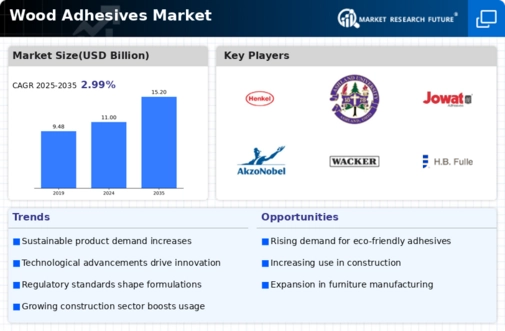Market Growth Projections
The Global Wood Adhesives Market Industry is projected to grow significantly, with estimates indicating a market value of 11.0 USD Billion in 2024 and potentially reaching 15.2 USD Billion by 2035. This growth trajectory suggests a compound annual growth rate of 2.99% from 2025 to 2035, reflecting the increasing adoption of wood adhesives across various sectors. The market dynamics are influenced by factors such as rising construction activities, technological advancements, and changing consumer preferences towards sustainable products.
Growing Construction Sector
The expansion of the construction sector is a primary driver for the Global Wood Adhesives Market Industry. As urbanization accelerates, particularly in developing regions, the demand for wood-based products in residential and commercial buildings increases. This trend is expected to contribute to the market's growth, with projections indicating a market value of 11.0 USD Billion in 2024. The construction industry increasingly relies on wood adhesives for structural integrity and aesthetic appeal, thereby enhancing the overall demand for these products.
Sustainable Building Practices
There is a notable shift towards sustainable building practices, which significantly influences the Global Wood Adhesives Market Industry. As environmental concerns rise, builders and manufacturers are increasingly adopting eco-friendly adhesives that minimize harmful emissions. This trend aligns with global initiatives aimed at reducing carbon footprints in construction. The market is likely to benefit from this shift, as consumers and businesses seek products that comply with sustainability standards. This could further bolster the market, potentially reaching a value of 15.2 USD Billion by 2035.
Regulatory Support for Wood-Based Products
Regulatory frameworks promoting the use of wood-based products are influencing the Global Wood Adhesives Market Industry positively. Governments worldwide are implementing policies that encourage sustainable forestry and the use of renewable materials in construction and manufacturing. Such regulations not only support the wood industry but also enhance the demand for adhesives that comply with these standards. As a result, manufacturers are likely to see increased opportunities in the market, fostering growth and innovation in adhesive technologies.
Rising Demand for Furniture and Wood Products
The increasing demand for furniture and wood products is a significant factor propelling the Global Wood Adhesives Market Industry. As disposable incomes rise globally, consumers are investing more in quality furniture, which often requires robust adhesive solutions for assembly and finishing. This trend is particularly pronounced in regions experiencing economic growth, where the furniture market is expanding rapidly. The anticipated growth trajectory suggests that the market could achieve a compound annual growth rate of 2.99% from 2025 to 2035, reflecting the sustained demand for wood adhesives.
Technological Advancements in Adhesive Formulations
Innovations in adhesive formulations are driving growth in the Global Wood Adhesives Market Industry. Advances in technology have led to the development of high-performance adhesives that offer superior bonding strength and durability. These innovations cater to diverse applications, including furniture manufacturing and flooring, where quality is paramount. The introduction of water-based and low-VOC adhesives reflects a growing emphasis on health and safety, appealing to environmentally conscious consumers. As these technologies evolve, they are expected to enhance market competitiveness and expand application areas.












